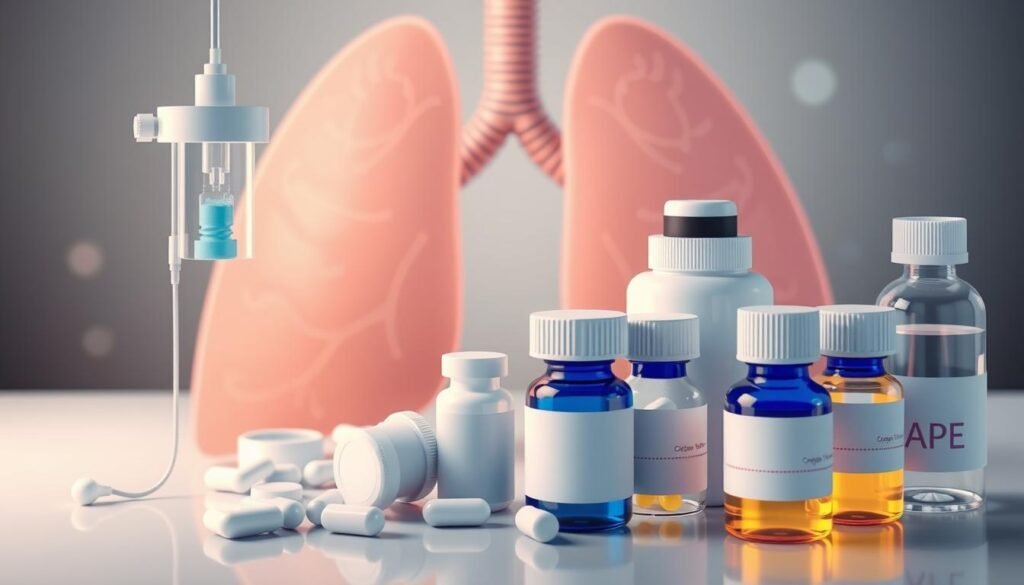Lung cancer ranks as the second most common cancer in the United States. Sadly, it’s often found too late, making early symptom awareness crucial. Everyone should know about lung cancer symptoms. They include a chronic cough, shortness of breath, and chest pain. Knowing about the lung cancer chest pain description is key to catching it early. This can greatly improve chances of successful treatment.
Spotting lung cancer early can change a patient’s survival odds. We’ll look at how lung cancer shows itself, mainly through chest pain. Knowing this can push for quicker doctor visits. This, in turn, boosts early detection benefits.
Key Takeaways
- Lung cancer is the second most common cancer in the U.S., often diagnosed at advanced stages.
- Chest pain is one of the key symptoms of lung cancer.
- Many symptoms, such as a chronic cough, can indicate lung cancer.
- Early detection significantly improves treatment effectiveness.
- Individuals at high risk include smokers and those with a family history of lung cancer.
- A routine screening is recommended for those with elevated risk factors.
What is Lung Cancer?
Lung cancer happens when cells in the lungs grow out of control. These tumors harm how the lungs work. Sadly, it causes the most cancer deaths worldwide.
Lung cancer comes in two main types: small cell lung cancer and non-small cell lung cancer. Heavy smokers often get small cell lung cancer. Non-small cell lung cancer has various forms and is more common.
About 20% of lung cancer patients don’t smoke. Radon gas exposure is also a big risk factor. Most people diagnosed are about 70 years old. This disease affects more men than women. Specifically, African American men have the highest rates.
Secondhand smoke can triple the lung cancer risk in nonsmokers. Chest pain is a usual symptom of lung cancer. It’s important to catch these signs early for better disease management.
Common Symptoms of Lung Cancer
Lung cancer symptoms vary, but key signs exist. A main one is a chronic cough that gets worse, lasting eight weeks or more. This cough might bring up blood or rust-colored spit, worrying many people.
Chest pain is another sign, worsening with deep breaths, coughs, or laughter. Many report shortness of breath and feeling very tired. People might also see unexplained weight loss and lose their appetite.
Other symptoms to watch for include a hoarse voice or frequent respiratory infections like bronchitis and pneumonia. Lung cancer might also spread, causing bone pain or changes in the brain. Knowing these signs early can lead to better treatment.
Knowing these signs helps people get medical help sooner. This is crucial for better outcomes with lung cancer.
Lung Cancer Chest Pain Description
Chest pain in people with lung cancer signals underlying issues. It’s crucial to understand this pain’s details. The pain varies in intensity and type, often linked to tumor growth in the chest. Recognizing these patterns helps distinguish lung cancer from other chest discomfort causes.
Types of Pain Associated with Lung Cancer
Lung cancer chest pain ranges from sharp stabs to dull aches. It stems from tumors pressing on tissues, nerves, or the lungs’ lining. Pain gets worse with deep breaths, coughing, or laughing.
- Deep breathing
- Coughing
- Laughing
About 20-40% of lung cancer patients report chest pain as their condition worsens, according to a 2022 review. This pain may increase due to other symptoms or complications.
When Chest Pain Occurs in Lung Cancer
Knowing when chest pain appears is important for patients. Early stages may show symptoms if a tumor blocks airflow or irritates tissues. But pain worsens as cancer progresses. In advanced stages, growing tumors or metastasis can pressure other organs. A 2021 study showed better survival rates with early treatment, highlighting the importance of quick action.
Patients with these symptoms should seek medical advice. Early recognition can improve treatment and outcomes. For more information, check out this resource on lung cancer symptoms.
Recognizing Other Lung Cancer Symptoms
Knowing different lung cancer symptoms is key for quick detection. If you catch these signs early, you can get help sooner. Look out for a lasting cough, breathing problems, and coughing up blood. These signs could point to serious health issues.
Persistent Cough
A cough that sticks around for over eight weeks may hint at lung cancer. At first, this cough could seem like other less serious conditions. If it gets worse or you start coughing up blood, see a doctor. This is crucial if you also have chest pain or are losing weight without trying. Learn more about early signs here.
Shortness of Breath
When lung cancer affects your lungs’ ability to work, breathing gets hard. This could be due to tumors blocking the airways or fluid around the lungs. If simple activities leave you out of breath, it’s time for a doctor’s visit. This symptom often comes with other worrisome signs of lung cancer.
Coughing Up Blood
Even a small amount of blood when you cough is a red flag. It could mean a big problem like lung cancer. The tumor may break blood vessels in your airways, leading to bleeding. This calls for urgent medical care.

How Lung Cancer Symptoms Differ by Stage
The way lung cancer shows itself can change a lot between stages. Knowing this can help catch it early, which is crucial. Early symptoms help spot issues before they get worse. On the other hand, late-stage lung cancer is tougher, showing why it’s key to watch how symptoms grow.
Early Stages
Early on, lung cancer might not seem serious. It can look like other, minor health problems. A study found that 59% of people in stage I didn’t feel sick at all. But, some early signs are:
- Persistent cough
- Shortness of breath
- Mild chest pain
These signs can be easy to ignore, leading to late diagnosis. Spotting these early signs is vital for catching the cancer soon.
Advanced Stages
When lung cancer gets worse, the symptoms become more serious. Stage IV is often when it’s first found, in 46.6% of people. Symptoms then include:
- Severe chest pain
- Significant respiratory issues
- Rapid weight loss
- Fatigue
Symptoms get worse as the cancer moves outside the lungs. Surprisingly, 27.7% of stage IV patients didn’t feel sick when diagnosed. It shows how complex and hidden lung cancer can be. If you have severe symptoms, getting help fast is key. For more, the Cleveland Clinic offers good info on treatments based on symptoms and stages.
The Importance of Early Detection
Understanding early detection in lung cancer is crucial. It can greatly change patient outcomes. Recognizing symptoms like a persistent cough and chest pain early helps. This encourages people to get medical help sooner. Early diagnosis can lead to better treatment, which improves survival rates for those caught in early stages.
Benefits of Recognizing Symptoms Early
Spotting early symptoms is key, especially for high-risk individuals. This includes people aged 50 to 80 with a heavy smoking history. But, only 21% of lung cancers are found early. Catching lung cancer at this stage opens up more treatment options. It also raises the chance of beating the disease.
Screening Recommendations
Regular screenings are a must for those at higher risk. They should get low-dose computed tomography (LDCT) scans yearly. This is advised by the US Preventive Services Task Force (USPSTF) and the National Comprehensive Cancer Network (NCCN). It’s important to talk to a healthcare professional about your risks. Screening can greatly reduce the risk of dying from lung cancer by 20-25%. For more on early symptoms, check here.

Understanding the Risk Factors for Lung Cancer
Knowing what increases lung cancer risk is key in stopping it early. Smoking, family history, and certain chemicals play big roles. Knowing these risks helps people lower their chances of getting sick.
Smoking and Secondhand Smoke
Smoking is the top cause of lung cancer. In the US, it’s behind 80% to 90% of such deaths. Even smoking a little can up your risk. But quitting can make a big difference over time. Also, secondhand smoke is dangerous for those around smokers. It can raise their lung cancer risk too.
Family History
Having lung cancer in your family can increase your risk. It can double if your family has a history of it. And if two or more close relatives had it, your risk jumps even more. Genetics play a part, so knowing your family’s health history is important.
Exposure to Carcinogens
Being around harmful substances can also lead to lung cancer. Things like asbestos, arsenic, and radon are risky, especially at work. For people working in certain industries, this risk goes up. Radon is the second major cause of lung cancer in smokers. It causes about 30% of lung cancer deaths in non-smokers. Staying safe at work and knowing your environment helps lessen this danger.
| Risk Factor | Impact Level | Notes |
|---|---|---|
| Smoking | High | 80% to 90% of lung cancer deaths; quitting reduces risks. |
| Family History of Lung Cancer | Moderate to High | Increases risk significantly; two or more relatives heighten chances. |
| Exposure to Carcinogens | Varied | Includes asbestos, radon, and workplace toxins; combined risks with smoking. |
| Secondhand Smoke | High | Increases risk due to inhalation of carcinogens. |
| Radon Exposure | Moderate | Second leading cause for smokers; prevalent in homes and offices. |
By staying informed and taking action, individuals can manage these risks. Learning about lung cancer risk factors is crucial for a healthy life.
Oncology Treatment Options for Lung Cancer
Finding the right lung cancer treatments is key to better outcomes and symptom management. Patients have different options based on the cancer’s traits, stage, and their health. Learning about these treatments helps patients take an active role in their care.
Surgery
Surgery often starts the fight against lung cancer, aiming at localized disease. Available procedures include:
- Lobectomy: Removal of a lung lobe.
- Pneumonectomy: Taking out an entire lung.
- Wedge resection: Cutting out a small lung portion.
The surgical method chosen usually depends on the cancer stage and location. Surgery can cure stage 0 non-small cell lung cancer (NSCLC) completely.
Radiation Therapy
Radiation therapy attacks cancer with high-energy rays. It’s vital for patients after surgery or those with inoperable tumors. This method can also ease symptoms from lung cancer’s effects. Stereotactic body radiotherapy targets with precision, needing fewer sessions.
Chemotherapy
Chemotherapy uses drugs to kill or slow cancer cells. It’s often primary for lung cancer, shrinking tumors before surgery. It also removes cancer cells left post-surgery. Combined with other treatments, it makes lung cancer care more effective and can boost survival chances.

Living with Lung Cancer
Dealing with lung cancer includes unique challenges, like managing pain and symptoms well. Those diagnosed often face various levels of discomfort. It’s key to manage this effectively to keep a good quality of life.
Managing Pain and Symptoms
Lung cancer pain varies, from mild aches to sharp pains. Patients should talk openly with their doctors about their pain. This helps in creating the right pain management plan.
There are several pain relief options:
- Medications, including over-the-counter and prescription
- Physical therapy to help with strength and mobility
- Complementary methods like acupuncture or meditation
Keeping in touch with healthcare teams is vital. It makes sure pain management stays effective. This communication is a big part of lung cancer support, aiding patients greatly.
Support Resources
Many support resources exist for those facing lung cancer. Groups like the American Cancer Society offer help. They provide access to:
- Counseling for emotional health
- Support groups to connect with others
- Informative resources for better choices
Using these resources helps fight the loneliness cancer brings. It builds a community around the patient. This boosts their quality of life. For more info on lung cancer, treatments, and management, patients should check reputable sources.
Conclusion
Understanding the symptoms of lung cancer, especially chest pain, is key for early detection. Lung cancer leads to more deaths from cancer in the U.S. than any other type. Because 47% of patients find out they have it in the late stages, knowing signs early is crucial.
About 47% of patients only realize they have lung cancer when it’s advanced. Many notice symptoms about six months before getting diagnosed. This shows why it’s vital to know the early signs of this illness.
Even though spotting symptoms early is critical, not many people get screened. In 2019, only 6.6% of adults were screened. We need to work on better diagnosis methods and encourage people to get screened sooner. Teaching people about the early signs can help them get help faster when something is wrong.
In the end, since lung cancer is the number one cause of cancer deaths for both genders, we must raise awareness. Understanding chest pain and other symptoms is essential for early treatment. Being aware and vigilant leads to quicker diagnoses, improving survival chances for those affected by this tough disease.